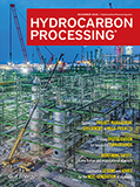Research and application of proprietary cold oil absorption technology in the recovery of refinery dry gases
With the increasing shortage of global energy and resources, the recovery and utilization of refinery dry gases have become important topics of concern.
IP: 10.1.103.123
This is a preview of our premium content. Thank you for your interest—please
log in or
subscribe to read the full article.
The Authors
Li, D. - Sinopec (Beijing) Research Institute of Chemical Industry, Beijing, China
Dong-Feng Li is the Chief Expert at the Sinopec (Beijing) Research Institute of Chemical Industry, pioneering oil absorption technologies. He has more than 20 yr of experience in the refining and petrochemical industries. He earned BS and MS degrees, as well as a PhD, in chemical engineering. Dr. Li can be reached at lidf.bjhy@sinopec.com.
Zhang, J. - Sinopec (Beijing) Research Institute of Chemical Industry, Beijing, China
Jing-Sheng Zhang is a Senior Engineer at the Sinopec (Beijing) Research Institute of Chemical Industry, where he is engaged in the comprehensive utilization of refinery dry gases. He earned a BS degree in chemical engineering and technology from the China University of Petroleum. He also earned a PhD in chemical engineering from the Chinese Academy of Sciences.
Liu, Z. - Sinopec (Beijing) Research Institute of Chemical Industry, Beijing, China
Zhi-Xin Liu is a Senior Expert at the Sinopec (Beijing) Research Institute of Chemical Industry, where she has explored the recovery of refinery dry gases for more than 15 yr. She earned an MS degree in chemical engineering.
Guo, L. - Sinopec (Beijing) Research Institute of Chemical Industry, Beijing, China
Liang Guo is the Director of the Production Technology Department at the Sinopec (Beijing) Research Institute of Chemical Industry. He has been focused on chemical processing developments and chemical engineering design for more than 15 yr. He earned a BS degree in chemical engineering from the Beijing University of Chemical Technology, along with an MS degree and a PhD in chemical engineering from Tsinghua University.
Hou, Z. - Sinopec (Beijing) Research Institute of Chemical Industry, Beijing, China
Zhuo-Ya Hou is a Technical Supporter at the Sinopec (Beijing) Research Institute of Chemical Industry. She primarily works on chemical processing designs and electrical engineering designs. She earned an MS degree in electrical engineering from the University of Queensland.
Hsu, R. - Sinopec (Beijing) Research Institute of Chemical Industry, Beijing, China
Kao-Chih “Ricky” Hsu is a Marketing Consultant at the Sinopec (Beijing) Research Institute of Chemical Industry. He previously worked for ExxonMobil for 18 yr. He earned an MS degree in chemical engineering and an MS degree in computer sciences from the University of Missouri at Rolla. Hsu can be reached at ricky_hsu@msn.com
Related Articles
From the Archive












Comments